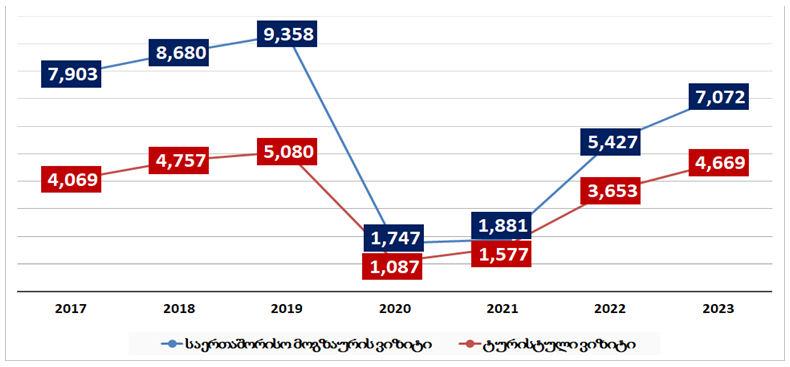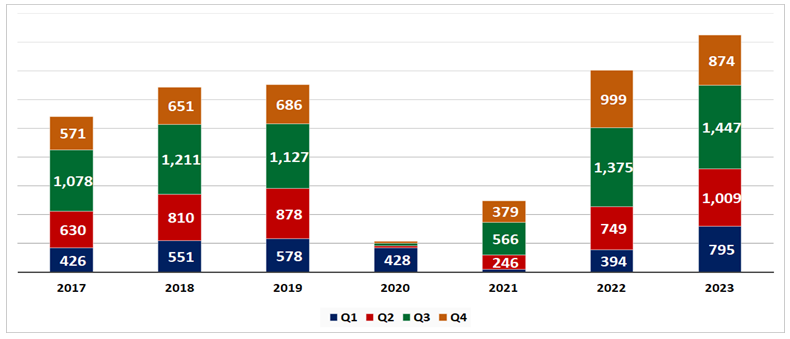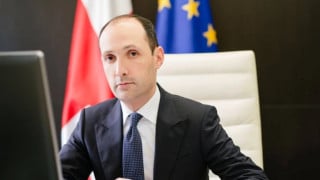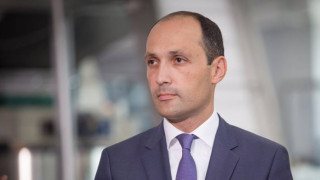Levan Davitashvili: “Income generated from tourism exceeds that of the pre-pandemic period by 26%.”
Verdict: FactCheck concludes that Levan Davitashvili’s statement is Mostly TRUE.
Georgia witnessed 5.1 million tourist visits, generating USD 3.3 billion from the sector in 2019. Following the downturn in 2020, signs of recovery emerged in 2021 with income from the sector surpassing USD 3.5 billion in 2022 and USD 4.1 billion in 2023. Furthermore, tourist visits reached 4.7 million in the previous year.
Whilst the Minister of Economics accurately presents the nominal figures, there are certain crucial factors overlooked, such as:
1) The real growth of income generated from tourism, considering purchasing power parity (PPP), constituted 6% rather than 26% as compared to 2019;
2) Income from tourism in the fourth quarter of 2023 declined by 13% as compared to the same period the previous year;
3) The average nights spent in Georgia by one visitor in 2023 reduced from 6.2 to 5.4 in 2023 as compared to 2022;
4) Payments with foreign cards in 2023 decreased by 2% to GEL 3.6 billion when compared to 2022.
Despite the accurate presentation of data, key factors were omitted that would provide a better understanding of the reality. Thus, FactCheck concludes that Levan Davitashvili’s statement is HALF TRUE.
Analysis
The Minister of Economics and Sustainable Development, Levan Davitashvili, highlighted the tourism sector during his appearance on TV Imedi show Imedi LIVE and stated: (from 13:12) “The data from the previous year reached record highs. We had a 26% growth as compared to the similarly record-breaking figures of 2019. Income from tourism totalled USD 4.1 billion, which was high. Over seven million international visits were recorded in Georgia and more noteworthy is that this figure surpassed 70% of the recovery of 26 (contextually, he was likely referring to 2019) when a record high of over 9 million visitors entered Georgia. However, tourist visits, a key driver of prosperity in the sector, reached 4.6 million in 2023 and marked an almost 100% recovery as compared to the figures of 2019.”
Tourism stands as one of the top priorities in Georgia, constituting 8% of the economy prior to the pandemic, and reaching 7% in 2022.
The 6.3% contraction of the GDP in 2020 (6.8% as per the old calculations) was substantially influenced by the halt in tourism resulting in a loss of potential income totalling USD 3 billion for the country.
Recovery was first observed in 2021 with income of 2022 exceeding that of 2019 in nominal terms. Growth persisted in 2023 as well; however, full recovery to pre-pandemic levels of tourist visits was not achieved, contrary to income.
A total of 9.4 million international visitors entered Georgia in 2019, including 5.1 million tourists. The figures for 2023 stood at 7.1 million and 4.7 million, respectively.
Graph 1: International Visitors in Georgia (1,000 visits)

Source: Ministry of Internal Affairs
The number of visits made by international travellers recovered by 76% as compared to the pre-pandemic rate, specifically, tourist visits exhibited an even more substantial recovery, reaching 92%.
A tourist is defined as a visitor who spends a night in Georgia. Therefore, tourist visits are more significant for income generation.
In addition to the absolute number of tourists, the average duration of stay by each tourist is another essential metric. The situation has shown improvement as compared to 2019 in terms of nights spent in Georgia. However, a decline is observed when compared to 2022.
Graph 2: Income from Tourism (USD million)

Source: National Bank of Georgia
Georgia faced a curfew that persisted until July 2021 with movement restrictions in place from 9:00 p.m. until 17 May, later extending to 11:00 p.m. for the next 1.5 months. The beginning of the year also witnessed several other restrictions and winter resorts remained non-operational. Consequently, although Georgia received almost no income from tourism in the first quarter, the following three relatively better quarters allowed the annual income level to reach 38% of the pre-pandemic figure.
Whilst tourism revenue surpassed USD 1.1 billion in the first half of 2022, it nevertheless remained USD 300 million less than the same period in 2019. However, the total income exceeded the 2019 figure by 8% due to an improved situation during the latter half of the year.
Income in 2023 exceeded USD 4.1 billion, suggesting a 17% increase as compared to 2022 and a 26% increase as compared to 2019. Moreover, whilst an increase was observed in all four quarters when compared to 2019, growth was only marked only in the first three quarters when compared to 2022.
In contrast to income, the volume of foreign card transactions decreased by 2%, reaching GEL 3.6 billion in 2023 as compared to 2022. However, a higher growth of 32% was marked in comparison to 2019.
The situation encompassing both income and the number of tourists could have been better if not for the official decision of Baku to keep the land border closed during the pandemic. Azerbaijan stood at the first place amongst visitors at 19.8% in 2019 but its share had decreased to 3.2% by 2023, moving the country to the fifth place. Revenues from Azerbaijani visitors also declined from 7.2% in 2019 to 3.4% in 2023. The number of visitors from Azerbaijan decreased 6.1 times and revenues dropped 2.1-fold. The aforementioned imbalance is likely attributed to the fact that relatively low-budget tourists arrived by land prior to the pandemic.
Contrary to Azerbaijan, tourism revenues from Russia, Turkey and EU countries have increased when compared to the pre-pandemic period.
Graph 3: Income from Tourism (USD million)

Source: National Bank of Georgia
According to information from the National Bank of Georgia, 30.5% of Russian citizens, 30.3% of Ukrainian citizens and 42.5% of Belarusian citizens are either residing in Georgia for more than one year or intend to do so as of 31 December 2023. The definition provided by the International Monetary Fund states that individuals in this category are considered residents of Georgia, hence their expenses are no longer reflected in tourism data.
Whilst tourism income from Russian citizens increased by 5% in 2023 as compared to 2022, the scenario varies quarter by quarter.
The overall drop in income was substantially influenced by the decline in the third and fourth quarters of 2023 with a 17% decrease in the former and a 48% decline in the latter. At the same time, Russia’s share in remittances experienced a decline from 60% to 23% in the fourth quarter of 2023 as compared to the same period of the previous year.
Despite the overall increase in income from Russia, the growth did not exhibit a jump-like movement. Russia’s share in tourism revenues constituted 23.7% in 2019, later increasing to 25.3% in 2022 and then decreasing to 22.7% in 2023. This increase may have been higher if Russian citizens who became residents were included in the statistics.
Inflationary pressures have become a prevalent issue globally in the post-pandemic period. Thus, it is crucial to determine not only nominal figures but also the volume of growth of real incomes. Despite the 26% increase in tourism income as compared to 2019, the real growth reduces to 6% when considering the purchasing power of a USD due to inflation and the fact that USD 3.3 billion in 2019 had the same purchasing strength as USD 3.9 billion in 2023.
The statement of the Minister of Economy holds accurate in nominal terms. Tourism income indeed exceeded USD 4.1 billion in 2023, indicating a 26% increase when compared to 2019. Although Levan Davitashvili accurately mentioned the number of international travellers, including tourists, and the percentages of tourism recovery, he overlooked certain key factors: the real increase in tourism income relative to 2019 amounted to 6% rather than 26% when considering the change in the purchasing power of the USD. Moreover, income from tourism decreased in the fourth quarter of 2023 when compared to the same period of the previous year and the number of nights spent by a visitor in Georgia, as well as the amount of money paid by foreign cards, also declined throughout the year. Thus, considering the accurately presented data but the omission of crucial factors, which would have provided a clearer understanding of the reality, FactCheck concludes that Levan Davitashvili’s statement is HALF TRUE.








